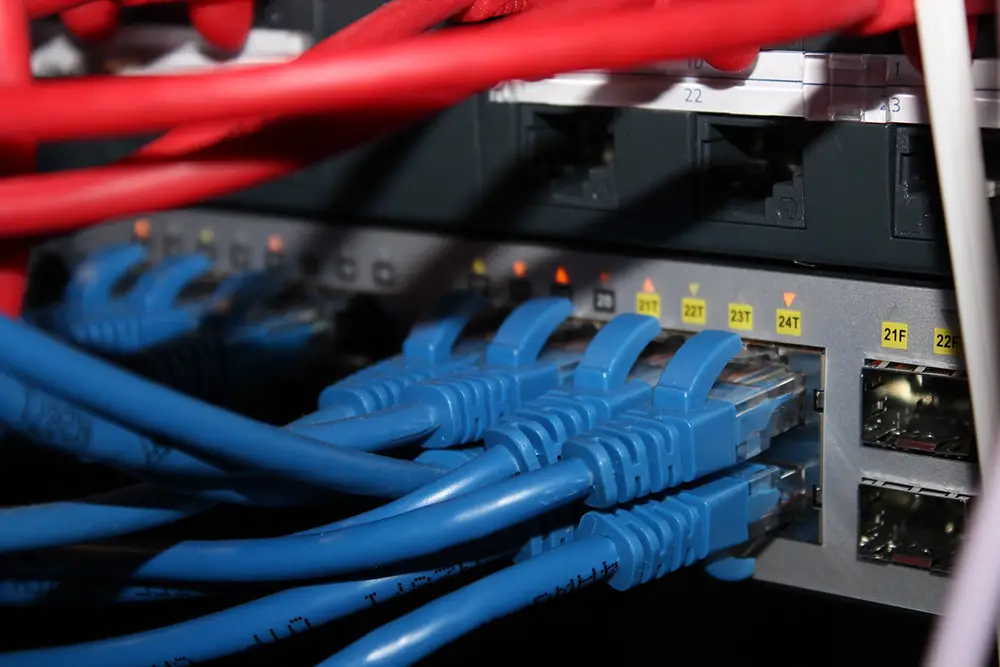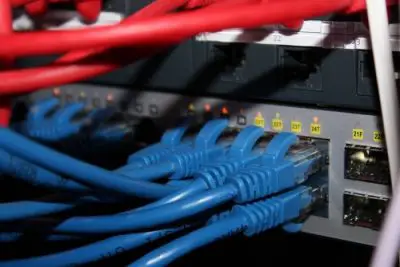Affiliate Disclosure: As an Amazon Associate I earn from qualifying purchases.
Patch panels are commonly used in enterprise networks, but not so much in home networks. Is there are reason for this, and will having a patch panel provide any benefits to a home network setup?
A patch panel is a piece of networking hardware used in both copper and fiber-based networks and contains a set number of ports to connect and manage both incoming and outgoing Ethernet cables. They allow for a more organized and manageable cabled network.
In this article, we’ll look at what a patch panel is, what they are used for, and whether you could benefit from having one as part of your own home network setup.
What Is a Patch Panel?
A patch panel is a panel with ports to plug Ethernet cables in the front and places to punch down the bare copper wire at the back.
Each port positioned at the front that is labeled with a number will connect via an Ethernet cable that has been punched down at the back. The numbers are simply an identifier for each port.
Where one end of the cable is punched down at the back, the other end is fed throughout your home, be it through the wall or ceiling space, to another location.
At the other end of the Ethernet cable, it will be terminated at a wall plate, making for a much cleaner installation.
Put simply, a patch panel is an array of ports found on a single panel. Each port connects via an Ethernet cable to another port located elsewhere in your home.
They are also commonly known as a patch bay, patch field or jack field.

What Are Patch Panels Used For?
Patch panels are used to better organize and manage all of the Ethernet cable found within your home network; they are one of the few components that are used in both copper and fiber-based networks and you can pretty much guarantee to find at least one within a business environment.
So what would a patch panel be used for in your home network setup?
Including a patch panel as part of a network setup comes with a host of advantages over simply running cables from each device directly to a central piece of networking equipment, most commonly a switch or router.
- Provides flexibility should you need to change something or if something breaks; you won’t need to re-run an entire length of cable.
- It allows for a cleaner and more organized way of managing all of your cables. Each individual port on the patch panel can be labeled which makes identifying the device connected at the other much easier, which is especially useful when troubleshooting an issue.
- Frequently pushing and pulling Ethernet cable can result in a loss of connectivity or even complete failure of the cable. The copper wires inside are very sensitive, so the less you have to touch them, the better. Punching down the cable into the back of the patch panel instead provides the cable relief where it isn’t subject to wear and tear.
- Whereas a stray Ethernet cable could end up connecting anywhere, the cable on the back of the patch panel will always correspond with a performant wall jack, again making everything easier to manage identify and troubleshoot.
Do I Need a Patch Panel?
A patch panel is not required but is recommended if you are running Ethernet cable across your home.
But what if you aren’t running any cable and just using Wi-Fi? In that case, there is absolutely no need for a patch panel, or perhaps even a switch, so don’t waste your money if you don’t need to.
If you do or are planning to, connect your home network up over Ethernet, I would strongly recommend getting a patch panel. No, they are not absolutely necessary, but I believe you’ll be pleased you got one when everything is set up.
Here are some reasons you may want to consider getting a patch panel for your home network:
- Easier identification of each cable and where it leads to in the home
- The structured environment looks much cleaner and tidier than loose cables sticking out a hole in the wall (the wife will particularly like this one!)
- Individuals rooms can be linked and organized much easier
- There are still options for alternative paths should the in-wall cable fail
- Prevents the last small amount of cable being moved, thus reducing the risk of damage
- The cable connected to the wall jack is easy to replace if needed
- Provides more flexibility when you are looking to repurpose a room
- Each part of your network can be segmented more easily
There are clearly many advantages of having a patch panel over not, but are there any disadvantages to having one?
The obvious downside is the additional cost to purchase the patch panel itself. My opinion, though, is that it is all part of the job and is just a cost to accept.
If you are going through the trouble of running cable through the walls or ceiling, it is worth finishing the rest of the job off properly and paying for a patch panel. In the grand scheme of things, they aren’t even that expensive.
There is also an investment of time needed in order to punch down the cables at the back of the patch panel. If you have many to do, this could take a while.
Finally, the patch panel is a fundamental piece of networking equipment; should anything go wrong with it, your entire cabled network may well grind to a halt. I don’t think this should be much of a concern though and certainly shouldn’t put you off getting a patch panel as they bring many more advantages over disadvantages.

Are There Different Types of Patch Panels?
Yes, there are many different types of patch panels available, despite them all looking pretty much the same.
Primarily, different patch panels are designed for the specific cable specifications they will accept, such as Cat5, Cat5e, and Cat6.
One specific type of patch panel will be needed for unshielded twisted pair (UTP) cable, whereas an alternative would be needed for shielded twisted pair cable.
You will also find patch panels with a differing number of available ports. 12, 24 and 48 port patch panels are amongst the most common for the number of connections they offer and greater flexibility and future-proofing they provide.
You may also like: What Is the Difference Between Cat5, Cat5e and Cat6 Cable?
Is There a Difference Between a Patch Panel and a Switch?
Many people will assume that a switch and a patch panel perform the same function as those who aren’t familiar, both require you to simply plug an Ethernet cable into an available port.
Patch panels and switches are very different, however, and it is important to know the differences between the two.
Think of a patch panel simply as a connector, whereas a network switch has much greater responsibility is connecting many devices to a network, allowing them to access the Internet amongst other functions.
A switch can be used in place of a patch panel in some cases and comes with its own advantages. Having a switch that simulates what a patch panel is capable is more expensive to purchase, though.
Related article: What Is the Difference Between a Managed and Unmanaged Switch?
Conclusion
A patch panel is a piece of networking equipment that allows for a cleaner, more organized way of managing the Ethernet cable running throughout your home.
One end of an Ethernet cable is punched down at the back and the other end is terminated at a wall plate.
Use another Ethernet cable to connect the port on the patch panel to an available port on a network switch or router and you should find the device you plug into the wall plate receives a network connection.
They are not absolutely necessary for a home network but highly recommended for the advantages it brings, such as a reduced risk of damage to Ethernet cable, a cleaner and tidy organization of cables, and easier identification of where each cable runs in your home.
There is the obvious additional cost required to purchase the patch panel itself and time investment needed to punch down each cable, but I feel they are worth it if you are looking to hook up your home network using Ethernet.
